
views
- Check the wound to see how deep it is; if you need to see a doctor, rinse the cut with water, but don’t attempt to clean it with household products.
- For minor deep cuts, clean it with soap and water and apply pressure to stop the bleeding, dress the wound, and keep an eye out for infection.
- For a severe cut, call emergency services; elevate the wound, apply pressure with a clean pad or bandage, and monitor the patient’s breathing.
- Get stitches or staples from a medical professional and take care of it as directed, avoiding activities that could strain the cut for 1-2 weeks.
Assessing the Wound

Check the wound. If you can see fat, muscle, or bone through your cut, or if the cut is wide and jagged, you will most likely need stitches. If you are unsure, you should check with a doctor or nurse. Signs that it is a problem needing quick attention can include any or a combination of the following: extreme pain, a lot of bleeding, signs of shock (such as cold, sweaty skin, feeling cold, or paleness of skin and appearance). You know a cut is through the skin if you can see fat (yellow-tan, lumpy tissue), muscle (deep-red, stringy tissue), or bone (tan-white, hard surface). However, any cut that is more than three centimeters long or 1/2 inch deep requires medical attention. If a cut does not go all the way through the skin, it does not need stitches, and can be cared for at home.

Prepare a serious wound for travel to a doctor. If you believe your cut needs emergency medical attention, there are a few things you can do to care for the wound before traveling to the emergency room. Quickly rinse the wound under water to wash away any loose debris or dirt. Try to wipe any debris or dirt away from the injury site first with sterile gauze to ensure that the water does not wash the debris into the wound. Next, apply pressure with a clean cloth or bandage and continue to hold pressure as you get transported to the emergency room. The wound will get cleaned again when you see your doctor to make sure it is thoroughly disinfected. If the wound is large and bleeding a lot, try to wrap the area with a towel or bandage, then continue to apply pressure. As you travel, try to position the wound above the level of the heart to reduce severe bleeding.

Do not attempt to thoroughly clean the wound or seal the wound with household products. Don't remove any object that does not wash away easily. If glass or debris is lodged in the wound, you can do more damage by trying to remove it yourself. Also, do not attempt to sew or glue the wound shut, as household products can cause infection and/or prevent healing. Do not use rubbing alcohol, hydrogen peroxide, or iodine to clean the cut, as it can slow healing.

Get to your doctor safely. If possible, do not drive yourself, as it may be dangerous. If you are alone and bleeding seriously, it may be a good idea to call an ambulance.
Treating a Minor Deep Cut

Clean the cut. Wash it well with soap and water for at least 5 to 10 minutes. Any type of soap and clean water is generally fine. Studies have shown that there is no significant difference if you use antiseptic solutions like hydrogen peroxide or antimicrobial soap for a generally clean cut. The key is to use copious amounts of irrigation. If there is dirt, glass, or another object in the cut that does not wash out easily, or if the wound is from a dirty or rusty object or animal bite, you should call your doctor.

Apply pressure to stop the bleeding. After the cut is clean, press a clean cloth or bandage to the area for at least 15 minutes. You can also help slow the bleeding by holding the cut above the level of your heart. To prevent the clotting blood from coming off when you remove the pressure dressing, you can use a nonstick cloth like Telfa gauze. If the cut continues to bleed after this, call your doctor.
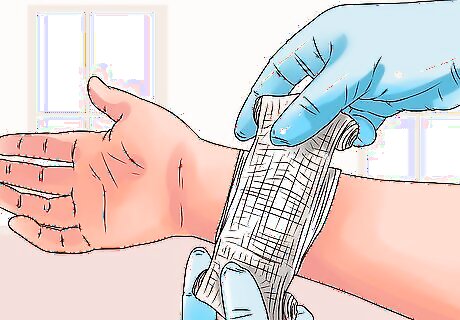
Dress the wound. Apply a thin layer of antibiotic ointment and cover it with a bandage or gauze. Keep the wound dry and clean by changing the bandage one or two times daily until it heals. Try to give the wound a couple hours of time in the open air after the first two or three days, as this helps speed healing.

Watch for infection. If you develop signs of infection, call your doctor. These include warmth or redness around the wound, pus draining from the wound, increased pain at the site, or fever.
Treating a Severe Deep Cut
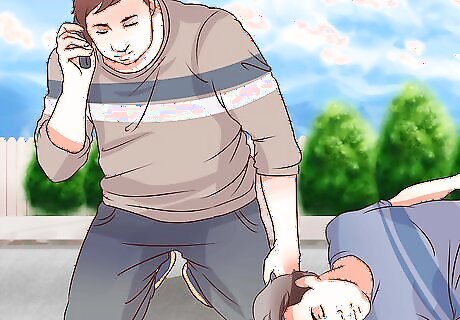
Call emergency services. It is important to get medical personal on the scene as quickly as possible. If you and the injured person are alone, you need to get extreme bleeding under control before going for help.
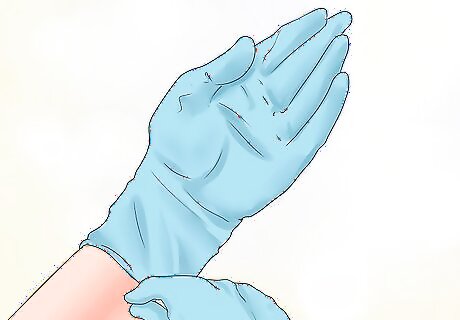
Place gloves on if you are treating someone else. It is important to keep a barrier between you and someone else's blood. Latex gloves will protect you from any possible transfer of disease from the other person's blood.

Check the severity of the wound and the injured person's responses to the injury. Also check the patient's breathing and circulation. Ask the person to lay down or sit down if possible, to allow the person to rest and relax. Check it to see what the problem is. Cut away clothing, if needed, so that you can see the wound. Be careful to avoid getting debris in the wound as you cut away the clothing.
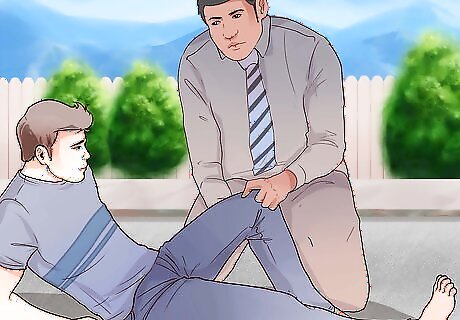
Assess life-threatening issues. If the wound is causing severe bleeding from an arm or leg, ask the patient to elevate his or her affected limb. Then, place supports under the limb, such as pillows or folded blankets, or have helpers hold it up. Keep it in this position until the bleeding stops. Shock can also be a life-threatening issue. If the patient is in shock, keep him or her warm and relaxed as possible. Symptoms of shock include pale, cold, clammy skin, disorientation, and decreased alertness. Do not try to remove any object, such as a glass splinter, unless you are properly trained to do so; removal could cause a great deal of blood loss if the item is the only thing stoppering the flow.

Dress the deep cut. Put a clean and non-fluffy dressing pad over the cut. Apply firm pressure directly to the cut. A compression bandage can be made from clothing, fabric, rags, etc., if you don't have any first aid bandages. If you have one available, wrap the compression bandage around the wound. Do not wrap too tightly; ensure that two fingers can slip under the bandage.

Place another dressing over the bandage if blood seeps through. Do not attempt to remove the existing dressing and bandage, as this would disturb the wound. Leave underlying bandages on. This will help to leave in place any clots that might form. These prevent more blood from flowing out of the wound.
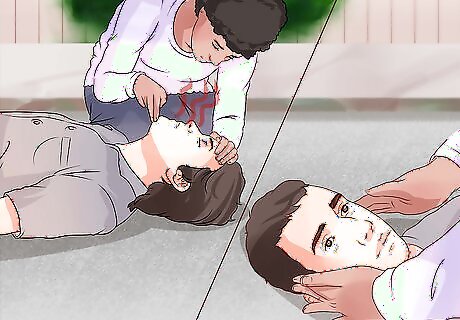
Monitor the patient's breathing and circulation. Reassure the person until help arrives (if severe) or until the bleeding stops (less severe). An ambulance must be called if the cut is severe and/or the bleeding fails to stop. Be sure to describe the person's injury when you call emergency services. This will make it easier for paramedics to arrive on the scene prepared to immediately assist.

Get further treatment from a medical professional. For example, if the cut was deep or dirty, you may need a tetanus shot. Tetanus is a serious bacterial infection that can cause paralysis and death if not treated. Most people receive a tetanus vaccine and boosters as part of their routine physicals every few years. If you are exposed to the bacteria through a cut from something dirty or rusty, it is important to get a booster shot to prevent future infection. Call your doctor to see if you need one!
Caring for Stitches and Staples

Get stitches, or staples, applied to a severe wound by a medical professional. If your cut is deep, wide, or jagged, your doctor may decide that you need stitches (a.k.a. sutures) or staples for it to heal well. When a doctor stitches or staples a cut, he or she will first clean the cut and give you numbing medicine by injecting it around the wound. After the doctor completes the stitches, he or she will dress the cut with a bandage or gauze. Stitches use a sterile surgical needle and thread to join the edges of a cut together. They can be absorbable, and dissolve over time, or non-absorbable, and will need to be removed after the wound heals. Staples used on cuts are special surgical staples that perform the same task at stitches and must be removed like non-absorbable stitches.
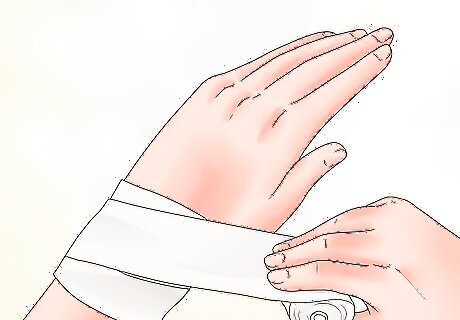
Take proper care of the wounded area. It is important to take care of your stitches or staples to make sure the wound heals well and does not get infection. To do this: Keep your stitches or staples dry and covered with a bandage for several days. The doctor should tell you how long this should be. It is usually one to three days depending on the type of stitches and the size of the wound. Once you can get them wet, gently wash the wound over the stitches or staples with soap and water when you shower. Do not submerge the wound underwater, like in a bath or when swimming. Too much water can slow down healing and result in infection. After washing the area, pat it dry and apply antibiotic ointment. Cover the area with a bandage or gauze unless otherwise directed by your doctor.

Avoid activities or sports that could hurt the area for at least one to two weeks. Your doctor should tell you specifically how long to do this. Stitches can break, causing the wound to open again. Call your doctor if this happens. Call your doctor if you develop signs of infection (e.g. fever, redness, swelling, drainage of pus, or red streaks radiating from the wound).

Return to your doctor's office once the wound has healed. Non-absorbable stitches and staples will usually be removed five to 14 days after they are put in. Once they are out, make sure to protect the scar from the sun using sunscreen or covering it with clothes. Ask your doctor if there are any lotions or creams they can recommend to help your scar heal.




















Comments
0 comment